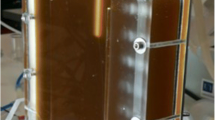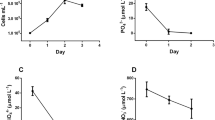Abstract
The study is focused on the ecological and physiological properties, production, and biochemical characteristics of the diatom Nitzschia amabilis. The optimum salinity (35‒36‰), illumination (2.95 klx), and photoperiod (14 h) at which the highest specific cell growth rate is achieved was determined. The coefficient of light saturation (Ik) was calculated and turned out to be lower than one, which indicates the high energy efficiency of photosynthesis. The results of experiments on salinity showed the ability of the alga to grow in the range of 4–68‰, indicating its relatively broad euryhalinity. The biochemical composition of N. amabilis during acumulative cultivation was studied. In general, polyunsaturated fatty acids predominated in the studied strain; eicosapentaenoic, arachidonic, and docosahexaenoic acids were dominant. The main share of saturated fatty acids consisted of palmitic acid. The productivity indicators of N. amabilis in relation to lipids, fucoxanthin, and PUFAs, which were 2.5–3 times higher in the flow cultivation mode than in the cumulative mode, have been established.




Similar content being viewed by others
REFERENCES
Mann, D.G. and Vanormelingen, P., An inordinate fondness? The number, distributions and origins of diatom species, J. Eukaryot. Microbiol., 2013, vol. 60, p. 414.https://doi.org/10.1111/jeu.12047
Apt, K.E. and Behrens, P.W., Commercial developments in microalgal biotechnology, J. Phycol., 1999, vol. 35, p. 215.
Patil, V., Kallqvist, T., Olsen, E., Vogt, G., and Gislerød, H.R., Fatty acid composition of 12 microalgae for possible use in aquaculture feed, Aquac. Int., 2007, vol. 15, p. 1.https://doi.org/10.1007/s10499-006-9060-3
Liyanaarachchi, V.C., Nishshanka, G.K.S.H., Premaratne, R.G.M.M., Ariyadasa, T.U., Nimarshana, P.H.V., and Malik, A., Astaxanthin accumulation in the green microalga Haematococcus pluvialis: Effect of initial phosphate concentration and stepwise/continuous light stress, Biotechnol. Rep., 2020, vol. 28, p. 1. https://doi.org/10.1016/j.btre.2020.e00538
Hustedt, F., Die diatomeenflora des küstengebietes der Nordsee vom dollart bis zur elbemündung. I. Die diatomeenflora in den sedimenten der unteren ems sowie auf den watten in der Leybucht, des Memmert und bei der insel juist, Abhandlungen des NWVs, 1939, vol. 31, p. 571.
Dunstan, G.A., Volkman, J.K., Barrett, S.M., Leroi, J.-M., and Jeffrey, S., Essential polyunsaturated fatty acids from 14 species of diatom (Bacillariophyceae), Phytochem., 1994, vol. 35, p. 155. https://doi.org/10.1016/S0031-9422(00)90525-9
Witkowski, A., Lange-Bertalot, H., and Metzeltin, D., Diatom flora of marine coasts I, In: Lange-Bertalot H. (Ed.) Iconographia diatomologica 7, Konigstein: Koeltz Scientific Books, 2000.
Suzuki, H., Nagumo, T., and Tanaka, J., Nitzschia amabilis nom. nov., a new name for the marine species N. laevis Hustedt, Diatom Res., 2010, vol. 25, p. 223. https://doi.org/10.1080/0269249X.2010.9705842
Rivera, P. and Cruces, F., Primer registro para Chile de las diatomeas marinas Nitzschia amabilis, Nitzschia elegantula and Chaetoceros muelleri var. subsalsum, RBMO, 2011, vol. 46, p. 95.
Kaleli, A., Kociolek, J., and Solak, C.N., Taxonomy and distribution of diatoms on the Turkish Mediterranean coast, Dalyan (Muğla), Mediterranean Marine Sci., 2020, vol. 21, p. 201. .https://doi.org/10.12681/mms.17293
Guiry, M.D. and Guiry, G.M., AlgaeBase. World-wide electronic publication, National University of Ireland, Galway, 2023, https://www.algaebase.org; searched on 26 September 2023.
Andersen, R.A. and Kawachi, M., Traditional microalgae isolation techniques. In: Algal culturing techniques, Andersen, R.A., Ed., Burlington, MA: Elsevier Academic Press, 2005, p. 83. https://doi.org/10.1016/B978-012088426-1/50007-X
Polyakova, S.L., Davidovich, O.I., Podunay, Yu.A., and Davidovich, N.A., Modification of ESAW medium used for the cultivation of marine diatoms, Mor. biol. Zh., 2018, vol. 3, p. 73. https://doi.org/10.21072/mbj.2018.03.2.06
Finenko, Z.Z. and Lanskaya, L.A., Growth and rate of division of algae in limited volumes of water, In: Ecological physiology of marine planktonic algae (in culture conditions), Khailov, K.M., Ed., Kyiv: Nauk. Dumka, 1971, p. 22.
Zheleznova, S.N., Gevorgiz, R.G., Bobko, N.I., and Lelekov, A.S., Nutrient medium for intensive culture of the diatom Cylindrotheca closterium (Ehrenb.) Reimann et Lewin - a promising object biotechnology, Akt. biotekhnol., 2015, vol. 14, no. 3, p. 46.
Lowry, O.H., Rosenbrough, N.J., Farr, A.L., and Randall, R.J., Protein measurement with the Folin Phenol Reagent, J. Biol. Chem., 1951, vol. 193, p. 265.
Agatova, A.I., Arzhanova, N.V., Lapina, N.M., Naletova, I.A., and Torgunova, N.I., Guide to modern biochemical methods for studying aquatic ecosystems that are promising for fishing and mariculture, Agatova, A.I., Ed., Moscow: VNIRO, 2004.
Dubois, M., Gilles, K.A., Hamilton, Y.K., Reber, P.A., and Smith, F., Colometric method for determination of sugars and related substances, Analytical Chemistry, 1956, vol. 28, p. 350. https://doi.org/10.1021/ac60111a017
Ryabushko, V.I., Zheleznova, S.N., and Nekhoroshev, M.V., Effect of nitrogen on the accumulation of fucoxanthin by diatoms Cylindrotheca closterium (Ehrenb.) Reimann et Lewin, Algologia, 2017, vol. 27, no. 1, p. 15.
Kates, M., Techniques of Lipidology: Isolation, Analysis and Identification of Lipids, Amsterdam: Elsevier, 1986.
Gevorgiz, R.G., Gontcharov, A.A., Zheleznova, S.N., Malakhova, L.V., Alyomova, T.E., Maoka, T., and Nekhoroshev, M.V., Biotechnological potential of a new strain of Cylindrotheca fusiformis producing fatty acids and fucoxanthin, Biores. Tech. Rep., 2022, vol. 18, p. 101098. https://doi.org/10.2139/ssrn.4081779
Gevorgiz, R.G., Zheleznova, S.N., and Malakhov, A.S., Productive characteristics of the culture of the diatom Cylindrotheca closterium (Ehrenberg) Reimann et Lewin in a two-stage chemostat, Mor. Biol. Zh., 2023, vol. 8, no. 1, p. 27. https://doi.org/10.21072/mbj.2023.08.1.03
Pasquet, V., Ulmann, L., Mimouni, V., Guihéneuf, F., Jacquette, B., Morant-Manceau, A., and Tremblin, G., Fatty acids profile and temperature in the cultured marine diatom Odontella aurita, J. Appl. Phycol., 2014, vol. 26, p. 2265. https://doi.org/10.1007/s10811-014-0252-3
Artamonova, E.Y., Vasskog, T., and Eilertsen, H.C., Lipid content and fatty acid composition of Porosira glacialis and Attheya longicornis in response to carbon dioxide (CO2) aeration, PLoS ONE, 2017, vol. 12, p. e0177703. https://doi.org/10.1371/journal.pone.0177703
Bedoshvili, Y., Podunay, Y., Nikonova, A., Marchenkov, A., Bairamova, E., Davidovich, N., and Likhoshway, Y., Lipid and fatty acids accumulation features of Entomoneis cf. paludosa during exponential and stationary growth phases in laboratory culture, Diversity, 2021, vol. 13, p. 459. https://doi.org/10.3390/d13100459
Yi, Z., Xu, M., Di, X., Brynjolfsson, S., and Fu, W., Exploring valuable lipids in diatoms, Front. Mar. Sci., 2017, vol. 4, p. 29. https://doi.org/10.3389/fmars.2017.00017
Preston, M., and Salim, R.M.A., Parenting style, proactive personality, and career decision self-efficacy among senior high school students, Humanitas Indonesian Psychological J., 2019, vol. 16, p. 116.
Shiratori, K., Ohgami, K., Ilieva, I., Jin, X.H., Koyama, Y., Miyashita, K., Kazuhiko, Y., Satoru, K., and Shigeaki, O., Effects of fucoxanthin on lipopolysaccharide-induced inflammation in vitro and in vivo, Exp. Eye Res., 2005, vol. 81, p. 422.https://doi.org/10.1016/j.exer.2005.03.002
Méresse, S., Fodil, M., Fleury, F., and Chénais, B., Fucoxanthin, a marine-derived carotenoid from brown seaweeds and microalgae: a promising bioactive compound for cancer therapy, Intern. J. Mol. Sci., 2020, vol. 21, p. 1. https://doi.org/10.3390/ijms21239273
ACKNOWLEDGMENTS
The authors are grateful to Sergei Ivanovich Genkal, Elena Leonidovna Nevrova, and Rinat Mukhametshaevich Gogorev for their help in determining the species of the strain.
Funding
The work was carried out within the state assignment of the T.I.Vyazemsky Karadag Scientific Station, Nature Reserve of the Russian Academy of Sciences, brunch of A.O.Kovalevsky Institute of Biology of the Southern Seas of the Russian Academy of Sciences, “Study of Fundamental Physical, Physiological-Biochemical, Reproductive, Population, and Behavioral Characteristics of Marine Aquatic Organisms” (no. 121032300019-0). The work used materials from the Scientific and Educational Center for Collective Use of the A.O. Kovalevsky Institute of Biology of the Southern Seas of the Russian Academy of Sciences, “World Ocean Diatoms Collection”. Biochemical analysis was carried out as part of the state task no. 121030300149-0.
Author information
Authors and Affiliations
Corresponding author
Ethics declarations
CONFLICT OF INTEREST
The authors of this work declare that they have no conflicts of interest.
ETHICS APPROVAL AND CONSENT TO PARTICIPATE
This work does not contain any studies involving humans or animals.
Additional information
Translated by M. Shulskaya
Publisher’s Note.
Pleiades Publishing remains neutral with regard to jurisdictional claims in published maps and institutional affiliations.
Rights and permissions
About this article
Cite this article
Polyakova, S.L., Zheleznova, S.N., Gevorgiz, R.G. et al. Ecological and Physiological Characteristics and Biotechnological Potential of Diatom Algae Nitzschia amabilis H. Suzuki. Russ J Plant Physiol 70, 165 (2023). https://doi.org/10.1134/S1021443723700309
Received:
Revised:
Accepted:
Published:
DOI: https://doi.org/10.1134/S1021443723700309




